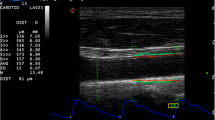Summary
Background
Xanthelasma palpebrarum (XP) is associated with increased risk of ischemic heart disease and myocardial infarction independent of other well-known cardiovascular risk factors. Cardio-ankle vascular index (CAVI) is a novel index of arterial stiffness and important marker of subclinical atherosclerosis. The purpose of this study was to investigate the association between XP and CAVI in asymptomatic subjects.
Methods
Consecutive 50 subjects with XP and age-gender matched 50 control subjects were enrolled. Patients with known atherosclerotic vascular disease were excluded. Arterial stiffness was assessed by CAVI and defined as abnormal if CAVI is ≥ 8.
Results
Subjects with XP had higher mean CAVI than control subjects (8.05 ± 1.72 vs. 6.76 ± 1.18, p < 0.001). Frequency of abnormal CAVI was higher in subjects with XP (n = 27) compared to those without XP (n = 9, 54 vs. 18 %, p < 0.001). There was a significant correlation between XP and CAVI (r = 0.42, p < 0.001). Conditional logistic regression analysis showed that XP (odds ratio OR 8.80, 95 % confidence interval CI 2.63–29.49, p < 0.001) and age (OR 1.17, 95 % CI 1.08–1.26, p < 0.001) were independent predictors for abnormal CAVI.
Conclusion
The study suggests that XP is associated with increased arterial stiffness in asymptomatic subjects.



Similar content being viewed by others
References
Christoffersen M, Frikke-Schmidt R, Schnohr P, et al. Xanthelasmata, arcus corneae, and ischaemic vascular disease and death in general population: prospective cohort study. BMJ. 2011;343:d5497. doi:10.1136/bmj.d5497.
Pandhi D, Gupta P, Singal A, et al. Xanthelasma palpebrarum: a marker of premature atherosclerosis (risk of atherosclerosis in xanthelasma). Postgrad Med J. 2012;88:198–204.
Akyüz AR, Ağaç MT, Turan T, et al. Xanthelasma is associated with increased amount of epicardial adipose tissue. Med Princ Pract. 2016;25(2):187–90. doi:10.1159/000441846.
Christoffersen M, Frikke-Schmidt R, Schnohr P, et al. Visible age-related signs and risk of ischemic heart disease in the general population: a prospective cohort study. Circulation. 2014;129(9):990–8.
Bergman R. Xanthelasma palpebrarum and risk of atherosclerosis. Int J Dermatol. 1998;37(5):343–5.
Laurent S, Cockcroft J, Van Bortel L, et al. European Network for Non-invasive Investigation of Large Arteries. Expert consensus document on arterial stiffness: methodological issues and clinical applications. Eur Heart J. 2006;27:2588–605.
Laurent S, Boutouyrie P, Asmar R, et al. Aortic stiffness is an independent predictor of all-cause and cardiovascular mortality in hypertensive patients. Hypertension. 2001;37:1236–41.
Blacher J, Asmar R, Djane S, et al. Aortic pulse wave velocity as a marker of cardiovascular risk in hypertensive patients. Hypertension. 1999;33:1111–7.
Yambe M, Tomiyama H, Hirayama Y, et al. Arterial stiffening as a possible risk factor for both atherosclerosis and diastolic heart failure. Hypertens Res. 2004;27(9):625–31.
Mancia G, De Backer G, Dominiczak A, et al. 2007 guidelines for the management of arterial hypertension: the Task Force for the Management of Arterial Hypertension of the European Society of Hypertension (ESH) and of the European Society of Cardiology (ESC). J Hypertens. 2007;25:1105–87.
Korkmaz L, Erkan H, Korkmaz AA, et al. Relationship of aortic knob width with cardio-ankle vascular stiffness index and its value in diagnosis of subclinical atherosclerosis in hypertensive patients: a study on diagnostic accuracy. Anadolu Kardiyol Derg. 2012;12(2):102–6.
Kanamoto M, Matsumoto N, Shiga T, et al. Relationship between coronary artery stenosis and cardio-ankle vascular index (CAVI) in patients undergoing cardiovascular surgery. J Cardiovasc Dis Res. 2013;4(1):15–9.
Park JB, Park HE, Choi SY, et al. Relation between Cardio-Ankle Vascular Index and Coronary Artery Calcification or Stenosis in Asymptomatic Subjects. J Atheroscler Thromb. 2013;20(6):557–67.
Okura T, Watanabe S, Kurata M, et al. Relationship between cardio-ankle vascular index (CAVI) and carotid atherosclerosis in patients with essential hypertension. Hypertens Res. 2007;30:335–40.
Nakamura K, Tomaru T, Yamamura S, et al. Cardio-ankle vascular index is a candidate predictor of coronary atherosclerosis. Circ J. 2008;72(4):598–604.
Sekikawa A, Shin C, Curb JD, et al. Aortic stiffness and calcification in men in a population-based international study. Atherosclerosis. 2012;222(2):473–7.
VaSera VS-1000 operation manual, Fukuhada Denshi CO., LTD, Tokyo, JAPAN. tp://www.fukuda.co.jp/english/products/special_features/vasera/cavi.html.
Park HE, Choi SY, Kim MK, et al. Cardio-ankle vascular index reflects coronary atherosclerosis in patients with abnormal glucose metabolism: assessment with 256 slice multi-detector computed tomography. J Cardiol. 2012;60(5):372–6.
Agac MT, Bektas H, Korkmaz L, et al. Androgenetic alopecia is associated with increased arterial stiffness in asymptomatic young adults. J Eur Acad Dermatol Venereol. 2015;29(1):26–30.
Jain A, Goyal P, Nigam PK, et al. Xanthelasma palpebrarum-clinical and biochemical profile in a tertiary care hospital of Delhi. Indian J Clin Biochem. 2007;22(2):151–53.
Segal P, Insull W Jr, Chambless LE, et al. The association of dyslipoproteinemia with corneal arcus and xanthelasma: the Lipid Research Clinics Program Prevalence Study. Circulation. 1986;73:I108–18.
Parker F, Odland GF. Experimental xanthoma: a correlative biochemical, histologic, histochemical, and electron microscopic study. Am J Pathol. 1968;53:537–65.
Ozdöl S, Sahin S, Tokgözoğlu L. Xanthelasma palpebrarum and its relation to atherosclerotic risk factors and lipoprotein (a). Int J Dermatol. 2008;47(8):785–89.
Author information
Authors and Affiliations
Corresponding author
Ethics declarations
Conflicts of interest
A. R. Akyüz, T. Turan, M. E. Erkuş, İ. Gürbak, S. Kul, L. Korkmaz, M. T. Ağaç, and Ş. Çelik declare that there are no actual or potential conflicts of interest in relation to this article.
Rights and permissions
About this article
Cite this article
Akyüz, A.R., Turan, T., Erkuş, M.E. et al. Xanthelasma palpebrarum associated with increased cardio-ankle vascular index in asymptomatic subjects. Wien Klin Wochenschr 128 (Suppl 8), 610–613 (2016). https://doi.org/10.1007/s00508-016-0989-6
Received:
Accepted:
Published:
Issue Date:
DOI: https://doi.org/10.1007/s00508-016-0989-6



